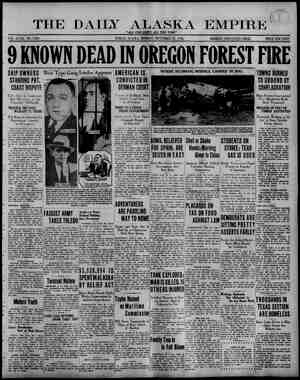Evening Star Newspaper, September 28, 1936, Page 18
You have reached the hourly page view limit. Unlock higher limit to our entire archive!
Subscribers enjoy higher page view limit, downloads, and exclusive features.
THE EVENING STAR, WASHINGTON, D. C, MONDAY, SEPTEMBER 28, 1936. M s e = R A o R e e ———— “You bet Washington can be proud of its Transportation !” LOT of things have happened to the transit system of America’s capital city in the past three busy years. New cars have been added —millions of dollars’ worth of track changes have been made—and more new buses have been put into service here in Washington than in any other city of comparable size in the land. During this time the number of passengers carried has stepped up 88 per cent—while the total revenue from fares paid has gained only 44 per cent — which means that people are enjoying this better transportation at a lower cost than ever. Take a fresh and honest look about you and you’ll see evidence of this improvement on every hand. Witness those handsome new ‘streamlined cars— riding on rubber-cushioned springs and shock absorbers— ventilated with a thousand cubic feet of fresh air a minute —and powered to sprint from a standing start to 40 miles an hour in ten seconds flat. Witness the fleet of 257 additional new buses, many of them serving neighborhoods which had no low-cost transportation before. Witness the average rate of fare—less than 6¢ for the city as a whole, with more than six people out of ten riding for just about 4c a trip.- And witness the job the transit system does—in bringing 80,000 people safely and punctually to work during the rush period every working day of the year. It takes hard work and hard cash to deliver such a service—but the Capital Transit Company promised to deliver, and the record shows that it is making good. TRANSIT FACTS AT A GLANCE IN the past twelve months, the Transit Company has operated its cars and buses more than 29,000, 000 miles and has carried more than 220,000,000 passengers. Because 80,000 people swarm to the heart of the city every week- day morning, it takes more than twice as many street cars and more than three times as many buses to handle the rush period as it takgs throughout the day. Washington is different from other cities in that its business offices and workshops are situated largely in one central area. This means that the working popula- tion rides in one direction at a time, and that street cars and buses must do half their rush- period traveling almost empty. As many as 85,000 people buy the Weekly Pass each week. Thou- sands of these Passholders ride at less than 4c a ride. Outside of the Government, the Transit Company has the largest number of employees (more than 3800 in July) and the largest monthly payroll (more than $528,000 in July) in the District. The Transit Company is owned by 2,101 individual stockholders of whom more than 74% live in the District. 257 new buses and 150 miles of new bus routes have been added in the past three years. CAPITAL TRANSIT COMPANY



